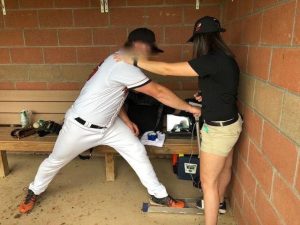
Baseball is a sport played by millions with incredibly high rates of arm injuries, especially in pitchers. A number of possible factors have been identified, including loss in total arc of motion¹ or a poor External Rotation/Internal Rotation strength ratio². While these are valuable and need to be looked at, the injury rates have remained exceedingly high in throwing athletes.
The majority of injuries occur during two phases of throwing:
- The late cocking phase, where the arm is in maximal external rotation
- The follow through, where the arm is decelerating
Deceleration requires the posterior rotator cuff and scapular stabilizers to eccentrically contract and slow the arm, which can be moving as fast as 100 mph at ball release (the hand is moving the same speed as the ball). Additionally, this occurs in a fully stretched position, where the pitcher has just completed a stride of 87% of his body height³. Replicating this movement clinically would likely be beneficial as it would replicate the demands in the most vulnerable position.
Early data is beginning to look at this, using a strength testing device designed by Damian Andrisani, MD. The athlete’s stride position is measured and the device is normalized to the athlete’s arm length and belt height. Once a pre-season measurement is obtained, a pitcher can be tracked throughout the season to allow insight into the health of their arm.
Each athlete has the device normalized to their individual height, arm length, and stride length
The measurements are sensitive enough to detect a change as the arm begins to fatigue either during a game or after multiple appearances. It would not be uncommon to see a pitcher’s measurements drop by 25% after throwing multiple innings.⁴
Additionally, early pilot data would suggest a rapid drop in strength occurs at some point during the pitcher’s performance, which may provide insight as to when the athlete should be removed from the game. The strength slowly slopes downward throughout a game, until a sudden drop-off is seen.
More data is required prior to widespread implementation, but the potential is endless. If we were able to objectively identify when a pitcher is fatigued, it would remove a large driver of injury. Currently, the only objective measure of fatigue is pitch count (we’ll discuss the limitations of this in a future post). Additionally, we could formulate a more objective measure of when a reliever has recovered and should pitch again. This may optimize pitching performance and minimize the potential for injury.
Looking for more on this? Follow me on Twitter
- Wilk KE, Marcina LC, Fleisig GS, et al. Correlation of glenohumeral internal rotation deficit and total rotation motion to shoulder injuries in professional baseball pitchers. American Journal of Sports Medicine. 2011;39(2):329-335.
- Byram IR, Bushnell BD, Dugger K. Pre-season shoulder strength measurements in professional baseball pitchers: Identifying players at risk for injury. American Journal of Sports Medicine. 2010;38(7):1375-1382.
- Whiteley, R. Baseball throwing mechanics as they relate to pathology and performance – A review. J of Sports Medicine. 2007;6:1-20.
- Andrisani D, Kaplan A. Unpublished Data from High School Baseball.

No comments:
Post a Comment